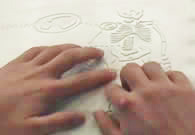DESIGN PRINCIPLES FOR TACTILE GRAPHICS
Planning and Editing
Planning the Graphic
Before you begin your graphic, take a few minutes to "incubate" your ideas. Try to synthesize the information that you are planning to illustrate. Think about the meaning you are about to attach to these symbols.
Areas
- Is the area distinguishable from surrounding areas? If it's a map, how do you know when you are in the water or on the land?
- If it's a graph, will the student be able to tell if (s)he is in the bar, or in the space between the bars?
- How many distinct areas will you portray in the illustration?
- Are they each significantly different?
- Are they so busy that you have created tactual noise?
- How are different areas defined-- by a line (imaginary boundary)? by an abrupt change in textures? by differences in height?
Lines
- Does the line represent…
- An imaginary boundary
- Something to follow (river route, street, Oregon Trail)
- A lead line to a label placed somewhere else?
- What tells the student what to do with the line?
Points
- Are they far enough from a line to distinguish?
- Are they distinguishable from the area?
Labels
- How much decoding is required of the student?
- If the label doesn't fit without covering most of the area, where does it go?
Keys/Legends
- Does the sample in the key match the illustration EXACTLY?
- Is it big enough to allow the student to perceive the texture?
- If the key takes more than a page, the illustration is probably too noisy!
Color
- Many students who read braille also have some visual acuity. If color can help with discrimination, use it!
- Sighted students see the blind student using the materials. Think about good Public Relations and projecting a more positive image of the student.

